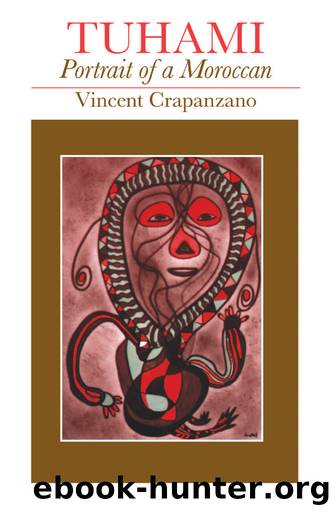Tuhami by Vincent Crapanzano

Author:Vincent Crapanzano [Crapanzano, Vincent]
Language: eng
Format: epub
Tags: Social Science, General, Anthropology, Cultural & Social, History, Africa, North
ISBN: 9780226191461
Google: uS1OCgAAQBAJ
Publisher: University of Chicago Press
Published: 2013-03-15T05:39:58+00:00
Part Four
There had been something desperate in Tuhamiâs last words: âEven my neighbors ask the same thing: why I donât get married. It irritates me. It is up to Allah. There is nothing I can do about it.â I knew that I could no longer maintain ethnographic distance. Tuhamiâs appeal was too great, and I myself too much of an activist, to accept what I understood then to be his passivity before forces externalized in âAâisha Qandisha, the saints, and ultimately Allah. I was a doer, and I came from a culture of doersâa culture that could accept as reasonable the maxim âNothing is impossible.â I had learned this maxim as a child, and others like it (âTry, try, and try again; and if at first you donât succeed, try, try againâ; âDonât give up the shipâ; etc.). I had read modern versions of Horatio Alger and understood self-help and Nietzscheâs notion of self-overcoming. I was angered by Tuhamiâs passivity before the demonic, his fatalism, his submission to Allahâs will, to what was âwritten.â His beliefs, I was convinced at the moment, held him back; they hindered his self-expression and impeded his self-reliance; they precluded the possibility of self-overcoming. They were a sanctioned ground for rationalization. There was, I realized, a limit to my relativism. I became a curer. I was leaving in two weeks. I was anxious for Tuhami. My wife and I even talked about staying longer, but that was impossible.
I write: âI became a curer.â In fact, I had already become a curer. This is evident in my notes, and the reader is certainly aware of the way in which Tuhami and I both negotiated our exchange into a therapeutic one. Tuhami provided me (and I feel the consequence of this even now, as I write) with the possibility for maneuver, manipulation, and cure, with the occasion for a vicarious participation that was perhaps not so vicarious after all. (My own father died when I was young, though not so young as Tuhami had been.) And he provided me with the occasion for that romance of adventure and exploration that was, I imagine, what drew me, and continues to draw me to anthropology and field research. The moment I have cited as marking my change of status is for me one of those fatal instants that mark a moment in what has been recollected and will be repeated. Repetition and recollection, Kierkegaard (1964, p. 33) tells us, âare the same movement, only in opposite directions; for what is recollected has been, is repeated backwards, whereas repetition properly so called is recollected forwards.â
âEthnographic distanceâ was a rhetorical device that enabled me both to mask my position and to rationalize it. Certainly, as I look back over my meetings with Tuhami, it is clear that the âdistanceâ between usâand the intensity of our involvementâvaried considerably, despite even the presence of Lhacen, my field assistant. The methodological strategies of the field worker are, as George Devereux (1967) has observed, frequently the result of his anxieties.
Download
This site does not store any files on its server. We only index and link to content provided by other sites. Please contact the content providers to delete copyright contents if any and email us, we'll remove relevant links or contents immediately.
| Central Africa | East Africa |
| North Africa | Southern Africa |
| West Africa | Algeria |
| Egypt | Ethiopia |
| Kenya | Nigeria |
| South Africa | Sudan |
| Zimbabwe |
Goodbye Paradise(3672)
Men at Arms by Terry Pratchett(2754)
Tobruk by Peter Fitzsimons(2419)
Arabs by Eugene Rogan(2239)
Pirate Alley by Terry McKnight(2158)
Borders by unknow(2153)
Belonging by Unknown(1780)
It's Our Turn to Eat by Michela Wrong(1636)
The Biafra Story by Frederick Forsyth(1592)
Botswana--Culture Smart! by Michael Main(1515)
The Source by James A. Michener(1506)
A Winter in Arabia by Freya Stark(1481)
Gandhi by Ramachandra Guha(1465)
Coffee: From Bean to Barista by Robert W. Thurston(1458)
Livingstone by Tim Jeal(1425)
The Falls by Unknown(1409)
The Shield and The Sword by Ernle Bradford(1339)
Africa: Altered States, Ordinary Miracles by Richard Dowden(1328)
Egyptian Mythology A Fascinating Guide to Understanding the Gods, Goddesses, Monsters, and Mortals (Greek Mythology - Norse Mythology - Egyptian Mythology) by Matt Clayton(1306)
